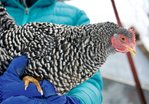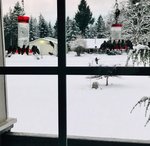


Perhaps the cutest thing about a snow day is seeing the tiny tracks of songbirds in the snow near the feeder.
The relationship between birds and those who supply the feeder is true symbiosis. Birds get nutritious meals and people are treated to the beauty of the feathers and songs.
Just like restaurants for people, there are busy and slow days at egg-layer eateries. Birds depend more on feeders when natural resources are depleted, such as during temperature extremes.
As snow and ice have rolled in over the last few days, Lewis County’s avians especially appreciate the extra help from locals. And it’s pretty simple to lend a hand, according to a representative from the Black Hills Audubon Society, who said: “Just making sure that the feeders stay dry and clean, and that hummingbird feeders stay thawed.”
Kaija’s Garden & Pet store in Chehalis has all the necessary supplies for the task, according to owner Patty Kaija on Facebook, including heat lamps and heat lamp reflectors to provide a hummingbird heating station.
The Farm Store also has those items in stock, a staffer told The Chronicle this week.
One “ingenious method” for the hummingbird feeder an employee at The Farm Store mentioned hearing was to tape a hand warmer to the bottom of the feeder, fill the nectar only halfway so there is less to keep warm and cover the liquid holding area with a wool sock or towel.
Another method for dealing with the nectar freeze is by keeping two feeders: one inside thawing while the other is outside freezing, then swapping them regularly. As always, the best and cheapest way to feed hummingbirds is by mixing a 1:4 solution of refined white sugar to tap water, the Audubon website stated. Nectar solutions with red food coloring could contain harmful chemicals for hummingbirds. The coloring is also unnecessary to attract the birds; the plastic flower on feeders is tempting enough for them.
For feathered friends on the farm, such as ducks or chickens, keeping water thawed is essential, according to The Farm Store employee.
“We’ve carried poultry water heaters but those are only meant for metal water holders. Another thing is a heat lamp close by if you have plenty of room away from flammable material,” the staff member said. “You can insulate your chicken house from the outside with cardboard or with an insulating material like a tarp just to keep the cold out.”
In larger tanks and ponds, an easy way to keep water thawed is by adding ping pong balls. The balls are light enough to float and get pushed around by wind, which keeps water moving and prevents freezing.
But for pets out of the wind in outbuildings and garages — which is ideal to protect them from windchill — a heating pad or straw bedding may be enough to prevent water from freezing. These same tricks can be used to keep sleeping areas warm overnight.
Chickens tend to hate the snow, while ducks can often tolerate low level snow. But for both types of fowl, if wings are clipped, they should generally be kept out of snow as much as possible. Predators are more active in the day when night temperatures are dropping to the low 20s, and snow can cause limited mobility for grounded birds.